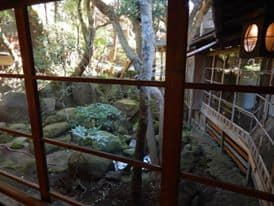What is it like staying in a Japanese ryokan as a single female traveler?
Let me walk you through this weird and wonderful experience, from arrival, tea, dinner, onsens, and the tatami sleeping mats. Staying in a Japanese ryokan as a single female? Don’t worry, we’ve got you covered.
A ryokan is a small, often family-owned, traditional Japanese inn or guest house, originating from Japan’s Edo period (1600-1800’s). With only a few guest rooms, guests are looked after by a host, and can range from the ultimate in high-end Japanese luxury, to a more casual feel.
I’ll start by saying I stayed at the Fukuzimiro Ryokan, located just outside Hakone (near Mount Fuji). This stunning, hundred year old timber structure has hosted Japanese poets, calligraphers, and guests of note. Quiet contemplation and peace echo through the ancient hardwood floors, disturbed only by the slippered feet of guests and the bubbling brook outside the courtyard, making it easy to see why it proves so inspirational to artists.
Although my experience was based on visiting Fukuzimiro, most ryokans operate in a similar fashion.

Costs
A traditional ryokan can be expensive, as it will include personalised service, large rooms or suites, breakfast and possibly dinner, served course by course in your room, and tea service. From memory, I paid about $250 AUD per night. Prices can vary widely, depending on ryokan and time of year. Most places also charge per person, not per room, which is different than western hotels.
I had also read that many ryokans don’t accept single guests (as clearly it would cut into their income, when they could receive twice as much per room), so I must’ve been lucky to come across this one. I visited in spring (sakura, or cherry blossom season), which is a peak time- many places I looked at were already booked out, so book well in advance if you are after a specific ryokan.
Arrival
On arrival, the entrance was very quiet, and I was greeted by a lovely older Japanese woman, who was to be my host throughout my time there. Her English wasn’t fluent, but was very good still, and we were easily able to chat. Which was good, because between her being the only English speaker at the ryokan, and me traveling alone, my conversation options would’ve been severely limited otherwise! Check in and out times are similar to most hotels- arrive late afternoon, check-out by 9 or 10am.
She instructed me to leave my shoes by the front entrance (where everyone else’s were), and to don a pair of slippers to walk around. Shoes aren’t to be worn inside, so get used to the slippers.

After being escorted to my room (more of a large suite than a room), she showed me around, following a tour of the facilities, and helped my try on my yukata, or house robe, to wear during my stay. This proved very handy for wearing to and from the onsen, and, regardless, wearing a cool Japanese robe beats normal clothes any day.
Should I get too cold, there was a warmer robe I could put on over my lightweight yukata, for extra warmth. Matrix within the matrix, I know…
The Room
The rooms are designed in a simple, but beautiful way, with wood paneling, large windows that slide open to look out over the river below, and mat flooring- the room evoked a feeling of zen and peacefulness, and would relax even the most anxious types.
As I was traveling alone and am very independent, I’m used to coming and going as I please, and looking after myself. So, at first I felt a bit awkward that this lovely woman was in charge of ensuring I had everything I needed, and that I was looked after to the best of her ability.
I came to accept the hospitality and of course to appreciate it as part of the culture, but for those who are very self-reliant, you may find the constant attention a bit odd at first. However, I was never made to feel uncomfortable or weird for traveling alone, so I had the impression that solo guests in ryokans are becoming more normal than maybe it had been in the past. Staying in a Japanese ryokan as a single female is definitely becoming common, as tourism to Japan grows each year.
Below: the ryokan’s courtyard and common rooms.
The experience is very different than a traditional hotel, from having to remember to leave your shoes in the lobby, the shared bathrooms, and the personalised service, it felt more like a homestay than a hotel.
Shortly after check in, my host came back through my room’s wooden sliding doors, offering a green tea service and biscuit. I never acquired a huge taste for green tea, but I must admit it tasted better here, especially on a chilly, early spring afternoon. The rest of the day was then free to check out the onsen, relax in the room, or go for a walk.
Want to read more Japan content? Check it out here.
Onsens
Onsens are indoor hot baths, or outdoor hot springs, and are extremely popular in Japan. Most ryokans will have their own onsens for guests. Be prepared to get naked with strangers and dive in- these are amazingly relaxing. For more on onsens, check out a previous blog here.
Ever been served a six course dinner, course by course, alone, on the floor of your own room, by a Japanese host?
Neither had I. In fact, it seemed like a huge amount of fuss to make over ‘just me’, albeit an incredible and delicious fuss. I almost felt guilty for taking up so much of the host (and chef’s) time on something so intricate and delicately prepared.
Once I relaxed and stopped feeling so awkward, it was easy to enjoy the experience. I sat on the floor of my room, wrapped up in my yukata, legs crossed in front of my little table. My host brought in each dish, explained to me what it was, then would come back in due course with the next one. Each portion was small, so it wasn’t overly filling. Unfortunately I visited almost two years ago (my blogging mojo was failing me at the time), so I can’t remember all the details of what was served, but it included white fish and a range of seafood, sushi and tempura, and sakura ice cream, none of which would be out of place in a five star restaurant.

Tatami Mats
After dinner, my host returned to lay out my sleeping futon, or tatami mat, along with blankets and a pillow. I’m starting to feel a bit bad for her at this stage, as she has been a gracious and amazing host for hours and hours now, her hospitality never wavering. She even plugged in an electric heating pad under my tatami, to ensure I stayed warm, despite sleeping on the floor. It’s a great way to sleep, and sort of surprising it hasn’t caught on more in the west- especially good if you have back problems.
Breakfast
Again, served to you in the room, many ryokans offer a choice between a Japanese or Western breakfast. After trying both at several establishments, it’s hard to say which is the clear winner, but don’t expect the Japanese interpretation of Western to be the same as yours.

Would I do it again?
Yes, 100%- a ryokan is an incredibly unique experience. That being said, would it be more meaningful with a partner or friend? Possibly, but whether as a couple or single traveler, I wouldn’t pass up on the opportunity. For more awesome onsen ryokans and hotels in the region, have a look here.
All comments and thoughts are my own, as I stayed here as a full-paying guest.
Have you stayed at a ryokan in Japan? What did you think?



